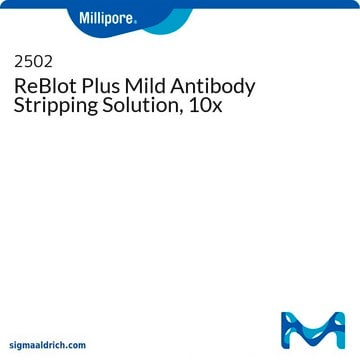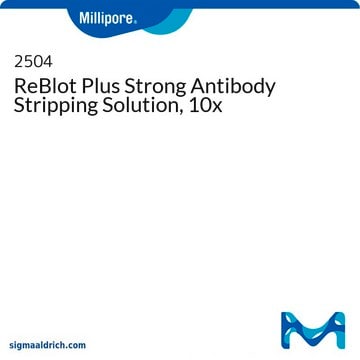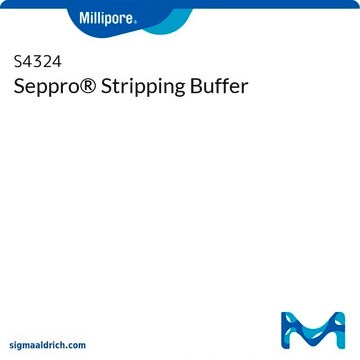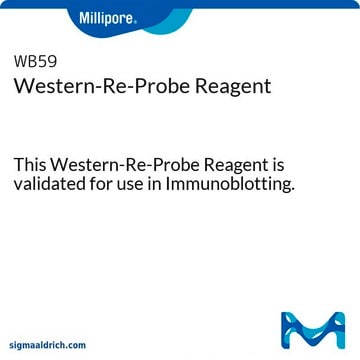About This Item
Polecane produkty
producent / nazwa handlowa
Chemicon®
Re-Blot™
Poziom jakości
metody
western blot: suitable
metoda wykrywania
chemiluminescent
Warunki transportu
wet ice
Opis ogólny
Stripping and reprobing of Western blots offers several advantages:
1) Conservation of samples that are expensive or available only in limited quantities,
2) Analysis of a given blot using several different antibodies, e.g. subtype- or isoform-specific antibodies,
3) Reanalysis of anomalous results and confirmation with the same or a different antibody,
4) Correcting errors in incubation with the wrong antibody,
5) Cost savings in reagents and time by reusing the same blot.
While antigen and antibody based immunoaffinity matrices, such as Sepharose™ conjugates, have been reused many times without compromising antigen-antibody reactivity, the need for pH extremes and chaotropic agents has precluded the application of these methods to Western blotting.
The MILLIPORE Re-Blot Plus Western Blot Recycling Kit contains specially formulated solutions that quickly and effectively remove antibodies from Western blots without significantly affecting the immobilized proteins.
Advantages of the Re-Blot Plus Western Blot Recycling Kit include:
- No pungent smelling β-mercaptoethanol is contained in the Antibody Stripping Solution.
- Antibody stripping is done at room temperature. No heating of blots is required.
- Blots can be stripped of antibodies in approximately 15 minutes at room temperature.
- Blots may be reused in 25 minutes.
Zastosowanie
The Re-Blot Plus Western Blot Recycling Kit should be used only for qualitative purposes until it has been established by comparative blot analysis that stripping does not quantitatively affect a given antigen.
This product is for research use only; not for diagnostic or in vivo use.
Komponenty
Strong Antibody Stripping Solution (10x) - (1 container, 50 mL).
Przechowywanie i stabilność
Note: To prevent reagent degradation secure the cap tightly upon storage. Avoid extended exposure to air.
Informacje prawne
Hasło ostrzegawcze
Danger
Zwroty wskazujące rodzaj zagrożenia
Zwroty wskazujące środki ostrożności
Klasyfikacja zagrożeń
Acute Tox. 3 Dermal - Acute Tox. 3 Inhalation - Acute Tox. 4 Oral - Aquatic Chronic 2 - Eye Dam. 1 - Met. Corr. 1 - Skin Corr. 1A
Kod klasy składowania
6.1C - Combustible acute toxic Cat.3 / toxic compounds or compounds which causing chronic effects
Certyfikaty analizy (CoA)
Poszukaj Certyfikaty analizy (CoA), wpisując numer partii/serii produktów. Numery serii i partii można znaleźć na etykiecie produktu po słowach „seria” lub „partia”.
Masz już ten produkt?
Dokumenty związane z niedawno zakupionymi produktami zostały zamieszczone w Bibliotece dokumentów.
Protokoły
This page shows and discusses three protocols for stripping and reprobing a western blot membrane.
Na tej stronie przedstawiono i omówiono trzy protokoły usuwania i reprobingu błony western blot.
Nasz zespół naukowców ma doświadczenie we wszystkich obszarach badań, w tym w naukach przyrodniczych, materiałoznawstwie, syntezie chemicznej, chromatografii, analityce i wielu innych dziedzinach.
Skontaktuj się z zespołem ds. pomocy technicznej











